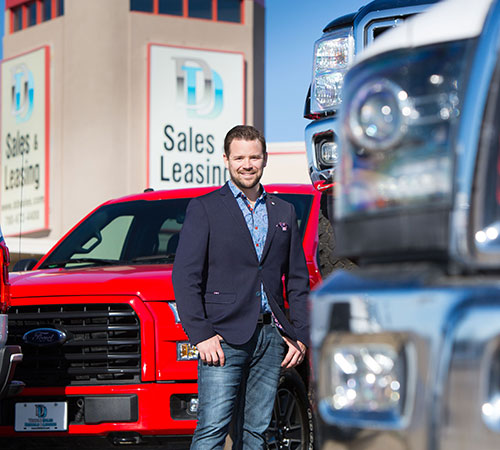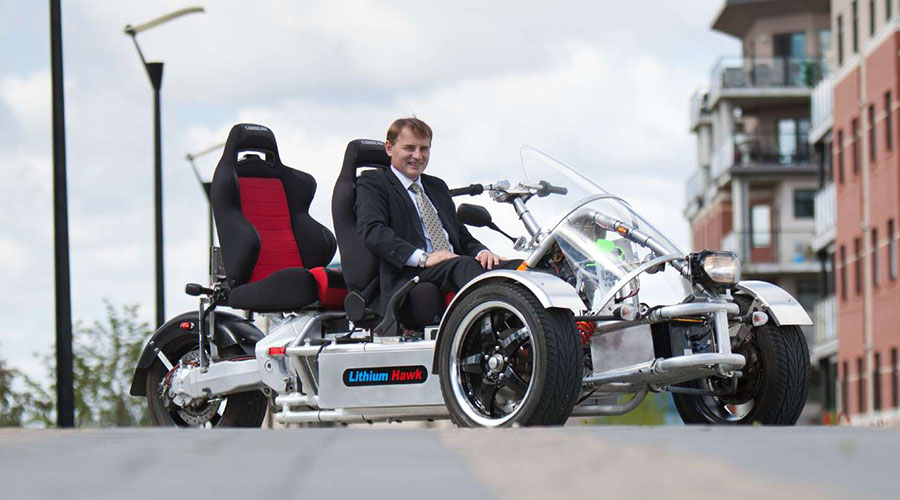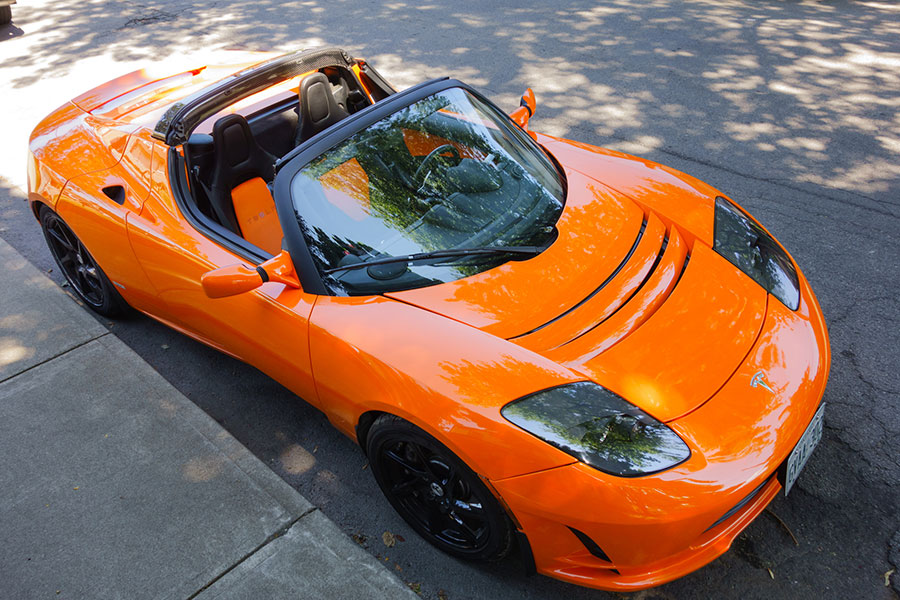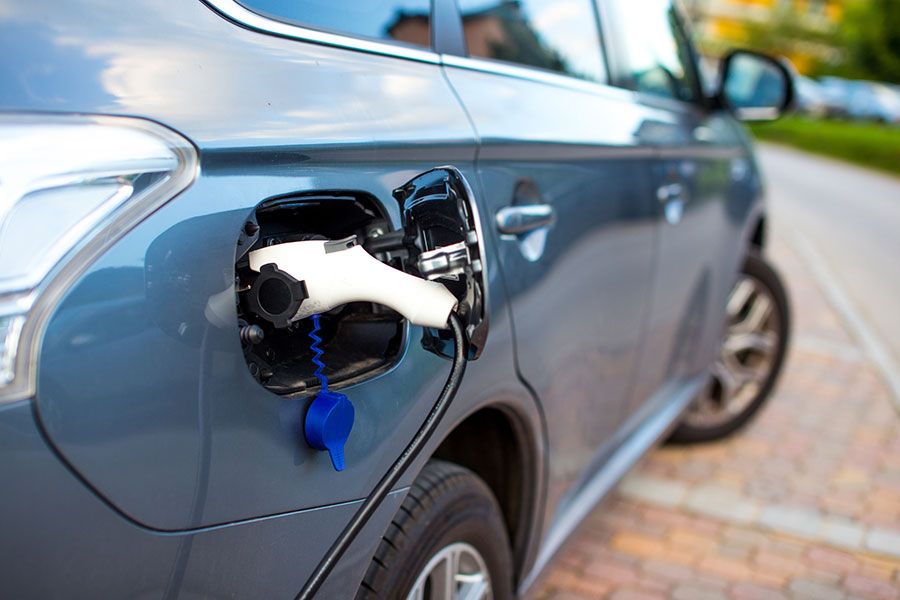“This is happening whether we like it or not”
In Alberta in 2019, the sight of a pricey Tesla zipping through traffic probably bears similarities to the appearance of the “horseless carriage” 150 years ago. Questions that might have come up then still apply. Is it a passing novelty, or is it the future? Who has the means – the nerve, even – to drive these things? What’s wrong with a horse? Or with a 450-horsepower pickup truck?
There is, at least, one commonality: curiosity. David Drever (Management ’07) confirmed as much during a spring 2018 event that was equal parts market research, sales pitch and even advocacy.
 The owner of D&D Vehicle Sales in Camrose, about an hour southeast of Edmonton, put an ad in a local paper to say he had three gently used Teslas at the lot, include two Model S sedans and one Model X SUV (both of which retail new for more than $100,000). He invited locals to come and give them a spin, and challenge any misconceptions he felt people have of electric vehicles being impractical, ugly and sluggish.
The owner of D&D Vehicle Sales in Camrose, about an hour southeast of Edmonton, put an ad in a local paper to say he had three gently used Teslas at the lot, include two Model S sedans and one Model X SUV (both of which retail new for more than $100,000). He invited locals to come and give them a spin, and challenge any misconceptions he felt people have of electric vehicles being impractical, ugly and sluggish.
The 32-year-old entrepreneur owns a Tesla himself – a Model S P85D. It does 0 to 100 kilometres per hour in 3.2 seconds. “You can blow the doors off pretty much any [other] car, while you’ve got your kids in the carseat in the back,” says Drever. “It’s by far my favourite vehicle that I’ve owned.”
“You can blow the doors off pretty much any [other] car, while you’ve got your kids in the carseat in the back.”
Alberta isn’t the first jurisdiction to come to mind as a place to get your electric motor running. To say nothing of our affection for pickups (which account for more than a third of new vehicle sales), there’s the distance between towns and cities. That’s a direct challenge to battery capacity, as are the frequent sub-zero temperatures that can sap electric charge.
But that might be changing. In February, the Alberta government announced a $1.2-million investment in the Peaks to Prairies Southern Alberta Electric Vehicle Network, a series of 22 charging stations along 1,700 kilometres of highway, forming a grid that stretches from Canmore to Medicine Hat, and from Calgary to Cardston. Powered by renewable energy, they’re meant to reduce emissions and boost economic development and tourism.
But, once it’s installed, a job that will be completed this December by network owner and operator ATCO, will drivers come? Will Alberta embrace the electric vehicle?
Drever recalls lineups during his three-day Tesla event. One of the cars even sold as a result, an unexpected bonus. His goal was simpler, almost a matter of public service. The world as he saw it was about to change, and he could help people prepare.
“I wanted people to see the technology that is coming down the road, how the industry is changing,” he says. “This is happening, whether we like it or not.”
A rough road (leading to a garage in Sherwood Park)
 That road, in North America at least, has been riddled with potholes.
That road, in North America at least, has been riddled with potholes.
Electric vehicles came out shortly after the first vehicles, competing with steam and gasoline power at the turn of the 20th century. But it took empty filling stations during the 1973 Oil Embargo for anyone to see them as a real alternative, and then only briefly. As the crisis subsided, so did interest in electric vehicles, which at the time topped out at about 70 KPH and tapped out after about 60 km.
They were considered cleaner, however. When U.S. lawmakers later began passing legislation to reduce emissions, General Motors saw an opportunity. In 1996, it launched the EV1, a fully electric vehicle that had sufficient range (i.e., battery power) for urban commuting. Yet just three years later, GM discontinued the model, citing concerns over profitability and disappointing electric car enthusiasts, such as Nap Pepin (Electronics Engineering Technology ’85).
Rather than mourn what could have been, Pepin put his education to work on filling the void. The result is what he calls the Lithium Hawk, an electric vehicle that he designed and built in his Sherwood Park garage, starting in 2010, for around $30,000. By August 2011, he’d logged 5,000 kilometres. He’s been tinkering with it now and then ever since.
“I always liked building go-karts when I was a kid, so it just evolved from there."
“I always liked building go-karts when I was a kid,” says Pepin, “so it just evolved from there into wanting to pull together something that was really interesting and cool, very high efficiency and really good performance.”
 The Lithium Hawk is no go-kart. The souped-up successor of Pepin’s first foray into electric cars, the BugE (which he donated to the Reynolds-Alberta Museum), can travel roughly 200 kilometres on a charge and do 0 to 100 KPH in six seconds. If you were to measure it for conventional fuel efficiency, it would come in at an equivalent of 0.81 litres/100 km.
The Lithium Hawk is no go-kart. The souped-up successor of Pepin’s first foray into electric cars, the BugE (which he donated to the Reynolds-Alberta Museum), can travel roughly 200 kilometres on a charge and do 0 to 100 KPH in six seconds. If you were to measure it for conventional fuel efficiency, it would come in at an equivalent of 0.81 litres/100 km.
Despite that, the vehicle is emblematic of the challenge electric faces in Alberta. It’s a unique, brilliant piece of machinery – slick, fast and efficient. But as a reverse trike, with two wheels up front, one in the back, and no roof, it was never intended for mass appeal, and looks like it may require courage to take out onto roads shared with all those trucks.
Pepin doesn’t let that get to him, at least in the summer. The Lithium Hawk handles beautifully, he says, but that alfresco design is a tacit admission that it was only meant for warmer months, when it gets him around town, and to work and back. Winter use wasn’t a consideration; the batteries, as with virutally all electric vehicles, simply wouldn’t perform during a month of -20 C, as we saw this February.
“There’s going to be slower growth [for the electric vehicle market] in this province just because of the climate,” says Pepin.
Like Drever, however, he might be willing to make room in the garage for Tesla, even though the company hasn’t licked the problem of six or seven months in a deep freeze. Instead it offers helpful tips on dealing with “increased range consumption during colder months.” Translation: “Yes, we know the batteries don’t last as long in winter.”
Given a choice, the three-wheeling Pepin would go for the Model X. “I’d definitely want an SUV for [its] height,” he says, “for vision and safety.”
The Tesla effect
 Because of its struggles, Tesla is a modern analog to the upstart Ford Motor Company, created by Henry Ford in 1903. To a point, at least.
Because of its struggles, Tesla is a modern analog to the upstart Ford Motor Company, created by Henry Ford in 1903. To a point, at least.
Ford’s path to success was wrought with stops and starts, including the creation and failure of precursor companies, fierce competition and lawsuits. But in 1908, the first Model T rolled off his revolutionary assembly line, which could build each in about 90 minutes. The pioneering innovation made the motor car affordable, launching a new era of personal transportation.
3 things to know before buying an electric vehicle
– Brian Lewis, Automotive Services Technician Instructor
1. “Know what your distance travelled will be.” What’s the range of the vehicle you’re considering? Is it up to the task?
2. Check access to changing stations. That applies not just to long-haul trips; you may also need to recharge at work during the day. A conventional 120-volt outlet won’t cut it.
3."Because the vehicle is usually more expensive” crunch the numbers up front. Will fuel savings offset that extra cost? “They’re coming down, but [electric vehicles] are more expensive than gas vehicles.”
Now 15 years old, Tesla had posted just four profitable quarters by the end of 2018. In recent months, it has cut tens of thousands of jobs, made plans to close most of its stores, and seen delays in delivering its own “Model T,” a sedan called the Model 3, designed to make its luxury electric brand accessible, at USD$35,000.
But Tesla has also succeeded in an important way: it has created a sense among consumers that the auto industry is ripe for disruption, with electric being an agent of change. And it has done so with a $0 advertising budget (not counting the $500 million CEO Elon Musk paid to launch, through his other company SpaceX, the Heavy Falcon rocket into orbit with a Tesla Roadster as its payload.)
“They’re really good at letting the community and their drivers be their ambassadors,” says Alyson Hodson (Marketing ’00), president and CEO of Edmonton-based Zag Creative. “It allows them to not have to be so overt with their marketing,” she adds, giving the brand and its product a “mystique” that Drever capitalized on at his Camrose dealership.
(For example, Hodson points out the word cheekily implied by the names of Tesla’s four models, S, 3, X, Y.)
But she feels that the company has yet to broaden its appeal beyond well-heeled early adopters. She includes herself in a psychographic she sees as Tesla’s target: environmentally conscious, forward-thinking people who are interested in innovation (that includes Tesla’s self-driving capabilities, she adds).
 Nor has its non-marketing efforts convinced her that an electric vehicle won’t, say, need a battery replacement in five years. For her to commit, “The technology also needs to be there.” That kind of thinking may also contribute to the current state of sales. In Q2, 2018, just 247 electric vehicles were sold in Alberta (of a total of nearly 70,000 new vehicle sales), compared to 2,564 in British Columbia., though its population is just 25% greater.
Nor has its non-marketing efforts convinced her that an electric vehicle won’t, say, need a battery replacement in five years. For her to commit, “The technology also needs to be there.” That kind of thinking may also contribute to the current state of sales. In Q2, 2018, just 247 electric vehicles were sold in Alberta (of a total of nearly 70,000 new vehicle sales), compared to 2,564 in British Columbia., though its population is just 25% greater.
Hodson would agree with Drever, though, that Tesla could be a tipping point in an increasingly diverse Alberta.
“The big automakers [are] starting to invest in electric vehicles,” says Drever, mindful of some two dozen electric vehicles hitting the market and adding to Tesla’s current handful of competitors.
The push is largely a response to the opportunity presented by the booming Chinese market, where the government is looking to reduce emissions and increase energy efficiency. Similar legislation is rolling out in North America and Europe. That investment is also attached to concern over Chinese manufacturers being ready and eager to supply the global market.
“Where attention goes, energy flows and results show. I think we’re going to see the technology improve at a much faster rate now that it’s on everybody’s radar.”
In his view, anxiety is bowing to aspiration. “It’s cool now to have an electric car,” says Drever. “[That] was all Tesla, coming out with one that was fast and good-looking.”
Leaps and bounds?
 Depending on which direction you’re pointed in Alberta, that anxiety may actually be a healthy thing.
Depending on which direction you’re pointed in Alberta, that anxiety may actually be a healthy thing.
North of the Peaks to Prairies system, the network of charging stations is densest in and around Edmonton, where there are about 50 of them. A driver of an electric vehicle could then travel straight east or west easily given current battery ranges. North is tougher going.
In the summer, a trip in a Tesla Model S to High Level from Edmonton, 739 km one way, would require a stop to charge up in Valley View, where there’s a free station at a Petro-Canada just off Highway 43. Going to Fort McMurray (435 km) means travelling via Athabasca, where another free charging station can be found at a Petro-Canada just off Highway 2. You could recharge in both destinations, but only to turn around and head back south; further north is a no-man’s land for electric vehicles.
At the moment, only the Hyundai Kona and Jaguar I-Pace could also go the distance in the pure electric category.
That’s why Brian Lewis (Automotive Service Technician ’00) feels that hybrid vehicles like the Lexus SUVs he and his wife drive, and which switch to gas-power engines when the batteries run low, are a more reliable choice in this part of the province.
The NAIT automotive instructor, who’s been updating classroom curriculum to reflect industry changes, would just as soon electrics came to the fore. They’re cheaper to maintain.
“You don’t have to do oil changes,” he says, because there’s no engine. Since they use electric power to stop, “you don’t need to change your brakes nearly as often.” (A conventional vehicle needs new pads after about 60,000 km, Lewis says.)
Electric vehicles are also cheaper to run. Electrician instructor Matt Charlton (Electrician ’00) puts the price per kilometre for a Tesla Model X SUV at 1.4 cents (based on an electricity price of 6.5 cents per kilowatt hour). A Ford F150 with fuel efficiency of about 10.7 litres/100 km runs 10 to 12 cents per kilometre, depending on the day’s price at the pumps.
Still, Lewis isn’t sure such advantages will spark a cultural change favouring electric. Without a trustworthy vehicle, Alberta can seem terrifyingly vast, a wilderness split by highways, but not tamed by them.
“My opinion is that plug-in hybrid [technology] that will get consumers more comfortable with [electric].” By the time that happens, he adds, electric may have made convincing advancements in range and charging time.
David Drever believes that’s underway. After a century free of disruption, “we’ve seen the automobile market evolve faster than it has in a very long time,” he says. “We’re seeing some big leaps and bounds in technology.”
“I think there’s a clear movement to try step away from fossil fuels for vehicles.”
Those leaps and bounds are almost big enough for Nap Pepin to put as much faith in the industry as he has in his own handiwork. “I think there’s a clear movement to try step away from fossil fuels for vehicles,” he says. To him, serious uptake looks five years out.
For now, however, Pepin is happy with his own hybridized approach to going electric. He’ll keep driving his pure-electric Lithium Hawk in warmer months. But when temperatures drop he’ll continue to revert to pure-petrol: his 2003 Honda Element, a discontinued, boxy SUV.
“I’ve always loved that vehicle,” Pepin says. The fuel efficiency isn’t excellent, he says, but that doesn’t concern him too much. What matters is that it suits his needs, and his life as it is today. It’s got rubber flooring, plenty of interior space and saloon-style side doors that make hauling stuff a breeze.
“Hopefully I can keep it running for a few more years.”

Is electric cleaner?
In 2015, the U.S.-based Union of Concerned Scientists released a report that compared carbon emissions of electric vehicles, including those from manufacture and disposal, with those of gasoline-powered vehicles. Findings suggested that, overall, electric is cleaner. How much depends on how the electricity is produced.
In the case of renewable sources – including geothermal, solar, nuclear, wind and hydro – carbon emission reductions ranged from 91% to 99% in comparison to a new 2014 gasoline-powered vehicle. Fossil-fuel generation drastically reduced that. Natural gas cut electric’s edge to 51%; coal produced a mere 1% advantage; oil, 0%.
“To reach their full potential, [electric vehicles] must account for a larger share of vehicle sales while the electricity grid shifts from coal to low-carbon renewable sources,” researchers reported.
In Alberta, the true environmental benefit of electric will depend on where charging happens. Though its major cities (Edmonton, Calgary and Red Deer) meet their electricity needs with natural gas, accounting for 39% of total provincial generation, coal-fired generation makes up roughly 50%. By 2030, Alberta currently plans to phase out coal and increase renewable energy sources to 30%.